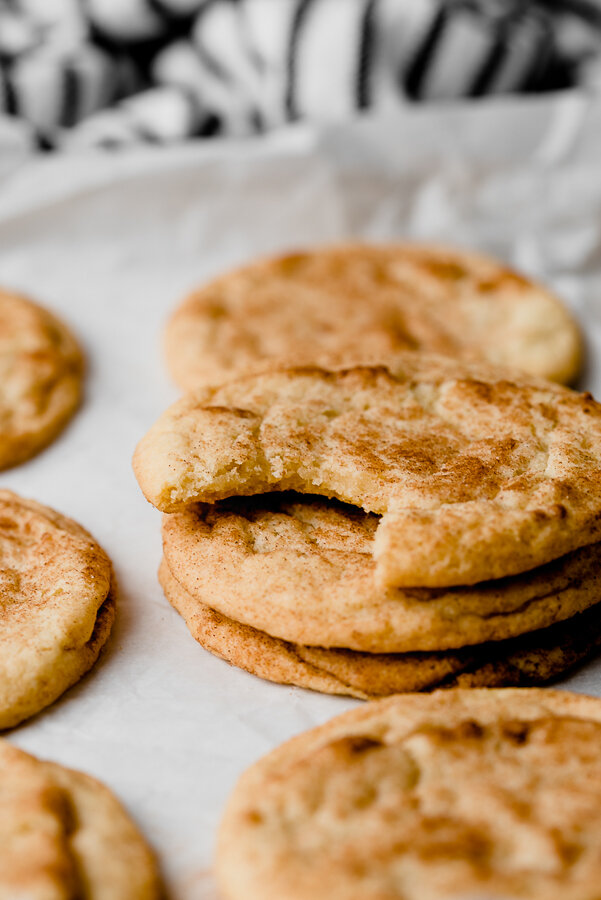Classic Snickerdoodles
These easy sugar cookies are rolled in cinnamon sugar, baked until soft and fluffy, and have deliciously crisp edges, making them the perfect nod to the changing seasons.
Snickerdoodles = YUM! If this is your first time staring down a snickerdoodle, it’s a good day. This recipe was passed down from my grandma, which I have updated and tweaked to make even better.
What makes a Snickerdoodle a Snickerdoodle?
It starts with a simple sugar cookie base, that has a couple teaspoons of cream of tartar. This ingredient—actually a byproduct of fermenting grapes in wine making—can’t be substituted, as this spice gives these cookies their signature flavor. Once the sugar cookie dough is scooped into balls, and chilled, they get dipped and swirled, into cinnamon sugar before baking. If you can’t already tell, they are pretty addicting, and uniquely themselves.
My Best Cookie Tips
I’ve studied the science of crafting cakes. I understood there would be skills and techniques needed, to achieve the ideal cake. But with cookies, I never put in the effort, because it’s a cookie! It should be easy, right?! Throw everything into bowl, swirl it around, throw it on a baking tray and BAM, perfect cookies.
But I quickly realized, cookies require the same patience and understanding as cakes. Different techniques, yes, but techniques nonetheless. Very few homemade cookies look like they came from a bakery—aka that nice thick cookie, with a chewy center, and a nice crunchy edge. Not flat pancakes, that are often misshapen and lackluster. So how is the perfect cookie achieved?
Ingredients matter, yes, but it’s actually the process that matters most. I have found a few key techniques, and tricks, that can turn cookies from flat and lifeless, to dreamy and delicious.
BUTTER—for cookies, butter should be room temperature, but not super soft. Around 65 degrees fahrenheit is the ideal temperature for butter. Have I actually tested this? Yes, yes I have! When softened butter is used—that still has structure—it makes a difference, helping the cookie stay nice and thick, while baking. When used at the correct temperature, butter is soft, and easily mixed into the dough, but is still able capsulate air, which aids in the overall texture and taste of the baked good. If butter is too soft, its capabilities dissolve, and from what I understand, don’t return, even if the butter is popped back into the refrigerator. Handle butter carefully and you will have better success in baking.
CHILLING COOKIE DOUGH—there is much debate on this topic, and without diving too deep, you will find some recipes require chilling cookie dough, while others don’t. I’m a firm believer, that chilling cookie dough is the number one step to improve the look, taste and texture of a cookie. There are some excellent recipes that don't require chilling cookie dough, like my Oatmeal Butterscotch Cookies found here, but thought needs to be put into a recipe that doesn't require chilling the dough, and there should be some explanation as to why it isn’t necessary. Questions answered like, what makes this recipe different? My point being, embrace the chilled cookie dough, it often makes a positive difference.
COOKIE TRAYS—not all cookie trays are created equal. I highly suggest getting a few half sheets like these, because they are versatile, and more importantly, aid in even heat distribution when baking in the oven. Quality half sheets don’t warp easily and can be used for all sorts of bakes. Further, I use silicon mats to line my half sheets, like these, because they clean easily, reduce waste, and most importantly, help produce cookies that are baked evenly, without burnt bottoms. Just an FYI, I purchase my half sheets and silicon mats at a local restaurant supply store. This a dreamy place for a baker, but also a nice affordable option, for anyone taking a serious interest in baking.
WEIGHING FLOUR—measuring flour incorrectly is the number one reason bakes turn our poorly. The absolute worst thing one can do is dip the measuring cup into the flour, and scoop it up haphazardly. When this is done, too much flour is compacted into the measuring cup, which often leads to a bake that is dry and dense. If you absolutely don’t want to invest in a kitchen scale, then you must spoon and level the flour, for an accurate measurement.
ROOM TEMPERATURE INGREDIENTS—in cookie making, bringing butter and eggs to room temperature allows the dough to emulsify properly, as it’s being mixed. It keeps the temperature, and consistency of the dough even, as it moves throughout, allowing for the creation of air pockets. When this happens, the finished product is chef’s kiss. If dairy isn’t put out before baking, (guilty as charged), you can read how to bring eggs and butter to room temperature quickly, here, under the section “bringing dairy to room temperature.”
Final Tip
Tips and tricks are minimal, as Snickerdoodles are such a simple cookie. If the directions are properly followed, a batch of these cookies can be whipped up with success.
Lastly, Snickerdoodles are my favorite cookie for ice cream sandwiches. They are fabulous with any milk based berry ice cream, chocolate, coffee, pumpkin, etc. You name the ice cream and Snickerdoodles pair perfectly.
Classic Snickerdoodles

Ingredients
- 1 1/2 sticks salted butter, room temperature
- 1 1/2 cups granulated sugar
- 2 eggs, room temperature
- 2 3/4 cups all-purpose flour
- 2 tsp cream of tartar
- 1 tsp baking soda
- 1/4 tsp salt
- 1/3 cup granulated sugar
- 3-4 teaspoons cinnamon to taste
Instructions
- Using a mixer with the paddle attachment cream butter and granulated sugar together on medium speed until light and fluffy, about two minutes. Add eggs scraping after each addition, mixing until incorporated.
- In a separate bowl combine the flour, cream of tartar, baking soda and salt. Weighing the flour will give you the most accurate measurement.
- Add dry ingredients into wet ingredients with mixer on low speed. Mix until incorporated, scraping the bowl to make sure dough on the bottom is mixed properly.
- Scoop or roll 3 tbsp size balls of dough onto cookie sheet, cover with plastic wrap, and refrigerate for at least three to five hours. If you need the cookies faster, the dough can be frozen for 1-2 hours. Cookie dough can be left in the refrigerator overnight and baked the next day.
- While the dough is chilling preheat oven to 375 degrees F. Line two baking sheets with silicon mats or parchment paper. Mix together the cinnamon and sugar into a small bowl.
- Once dough balls have chilled thoroughly dip them in the rolling mixture before placing them on the cookie sheet a few inches apart. Using a half sheet, bake six cookies at a time.
- Bake for 6 minutes and rotate pan. Bake for 5-6 minutes more. Baking time varies depending on desired doneness and scoop size, so watch the cookies carefully.
You May Like These…























